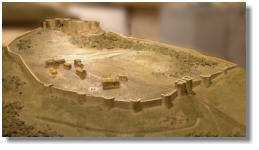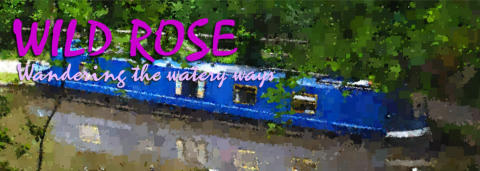

A BEEST OF A CASTLE
Built by Ranulf, 6th Earl of Chester, in the 1220s, Beeston Castle castle incorporates the banks and
ditches of an Iron Age hillfort. Henry III seized the castle in 1237 and it remained in royal ownership
until the 16th century. During the Civil War (1643-1645) there were multiple battles and the castle
passed from Parliamentarian hands, back to besieging Royalists, then back to the Parliamentarians,
and then again to the Royalist cause. But as we all know Cromwell got it in the end. The last Royalist
defenders finally left, it is said, having eaten all the cats!
The picture shows a model of the castle in its heyday.
One of the more extraordinary surviving features is the
well situated in the inner bailey which is 370 feet deep!
Attempts to explore the well with sophisticated electronic
measuring equipment show that at least three passages lead
off from the main shaft. This is an amazing feat of engineering
by any standards, but that it should have been excavated in the 13th Century is even more mind
boggling. However it leads to another mystery concerning the missing treasure of Richard II. Richard
is reputed to have secreted his wedge in the castle while he nipped off to Ireland in 1399. On his
return he was captured by Henry Bolingbroke, Duke of Lancaster who later became Henry IV and
even later a two part drama by William Shakespeare. Richard died in captivity in 1400 without
revealing the location of his treasure reputed to have been 100,000 marks in gold coin and the same
value in precious objects. Assuming that a gold mark was eight ounces at that time then the stash is
now equivalent to about £16,000,000. It is considered these days that the obvious place for him to have
hidden it, is in the well…
There is another castle on the hill opposite Beeston Castle complete with large sandstone towers,
defensive crenellations and a rocky moat to match. But this, Peckforton Castle, is a Victorian fantasy
built by the aristocratic and, presumably, slightly mad John Tollemache. He purchased the Beeston
estate in 1840 and decided that one castle was not enough.
That well…
Remnant of outer wall
Inner bailey
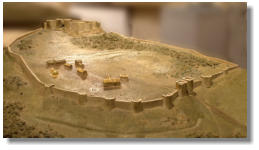
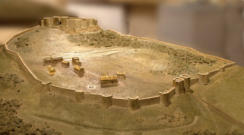
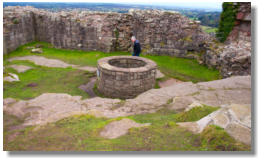
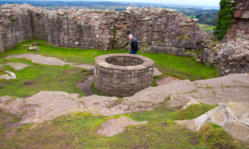
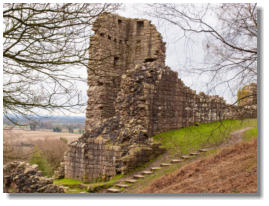
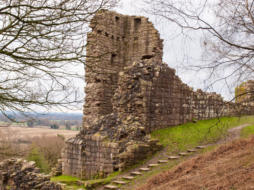
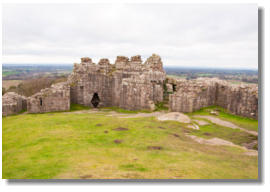
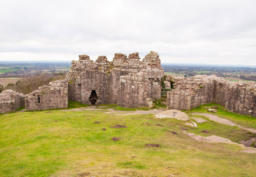


A BEEST OF A CASTLE
Built by Ranulf, 6th Earl of Chester, in the 1220s, Beeston
Castle castle incorporates the banks and ditches of an Iron
Age hillfort. Henry III seized the castle in 1237 and it
remained in royal ownership until the 16th century.
During the Civil War (1643-1645) there were multiple
battles and the castle passed from Parliamentarian hands,
back to besieging Royalists, then back to the
Parliamentarians, and then again to the Royalist cause.
But as we all know Cromwell got it in the end. The last
Royalist defenders finally left, it is said, having eaten all
the cats!
The picture shows a
model of the castle in
its heyday.
One of the more
extraordinary
surviving features is
the well situated in the inner bailey which is 370 feet
deep!
Attempts to explore the well with sophisticated electronic
measuring equipment show that at least three passages
lead off from the main shaft. This is an amazing feat of
engineering by any standards, but that it should have
been excavated in the 13th Century is even more mind
boggling. However it leads to another mystery concerning
the missing treasure of Richard II. Richard is reputed to
have secreted his wedge in the castle while he nipped off
to Ireland in 1399. On his return he was captured by
Henry Bolingbroke, Duke of Lancaster who later became
Henry IV and even later a two part drama by William
Shakespeare. Richard died in captivity in 1400 without
revealing the location of his treasure reputed to have been
100,000 marks in gold coin and the same value in precious
objects. Assuming that a gold mark was eight ounces at
that time then the stash is now equivalent to about
£16,000,000. It is considered these days that the obvious
place for him to have hidden it, is in the well…
There is another castle on the hill opposite Beeston Castle
complete with large sandstone towers, defensive
crenellations and a rocky moat to match. But this,
Peckforton Castle, is a Victorian fantasy built by the
aristocratic and, presumably, slightly mad John
Tollemache. He purchased the Beeston estate in 1840 and
decided that one castle was not enough.
That well…
Remnant of outer
wall
Inner bailey
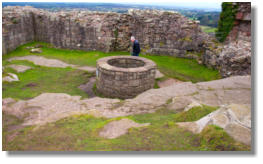
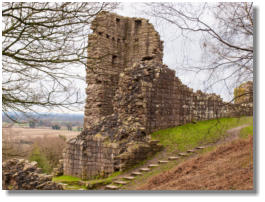
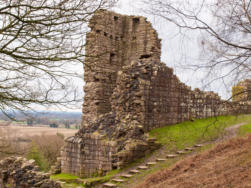
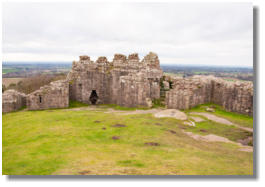
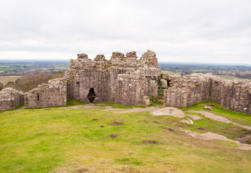

nb Wild Rose
